How to Facilitate Brainstorming Sessions in Meetings
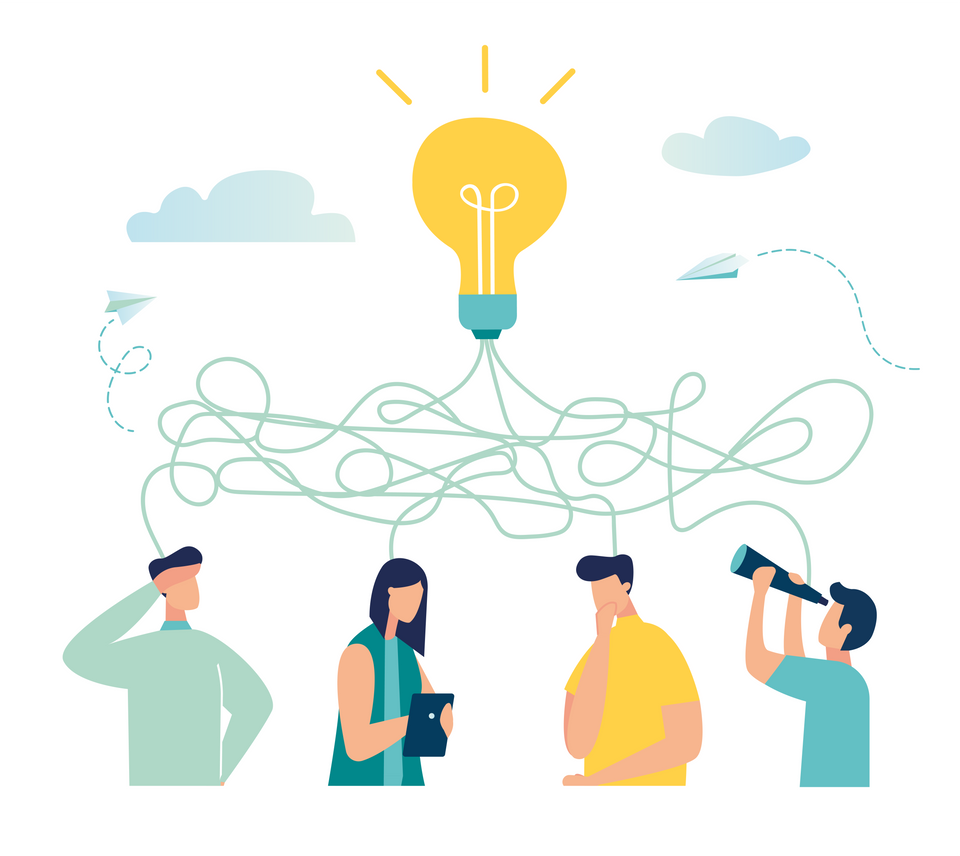
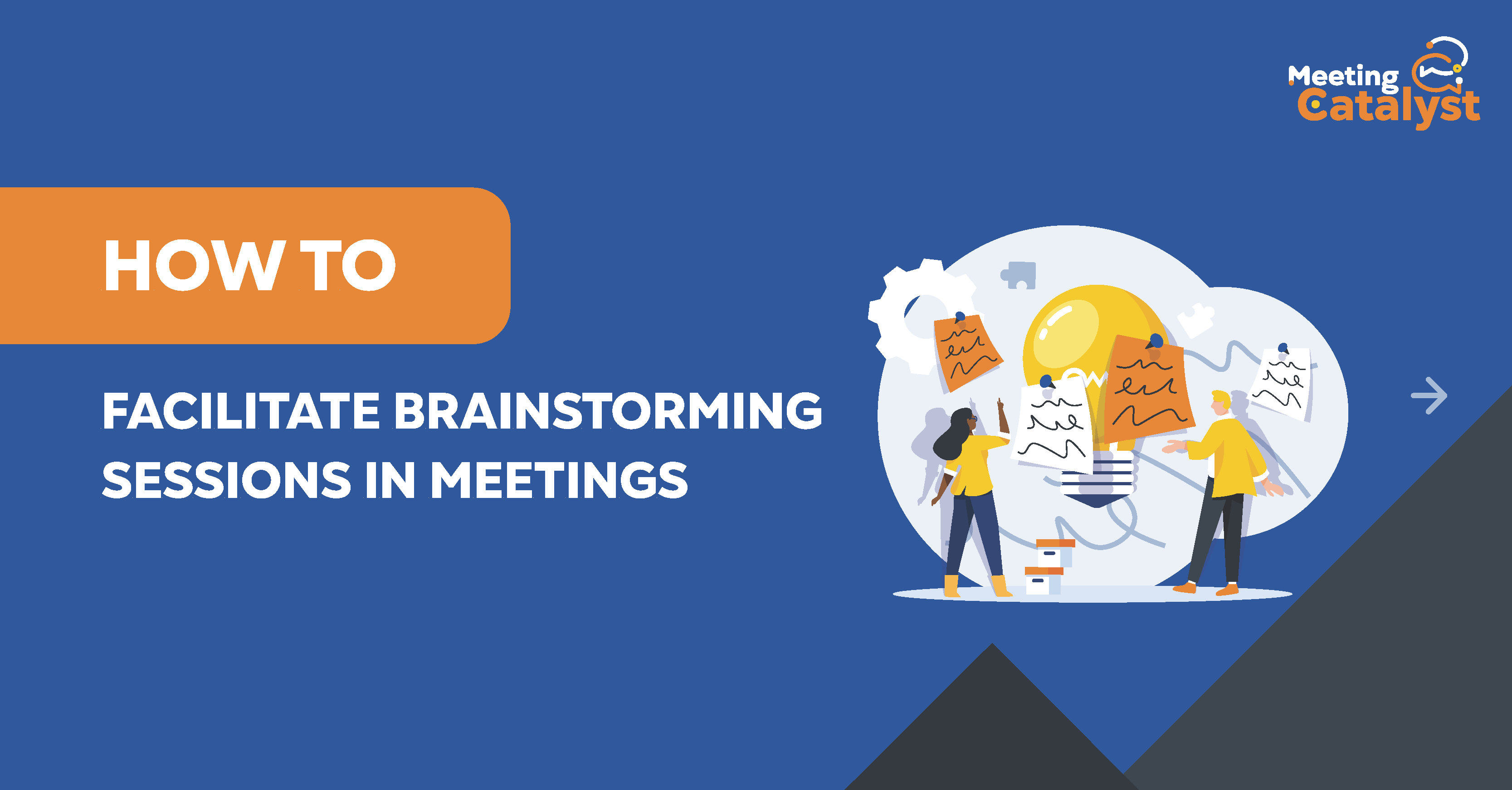
Introduction
Brainstorming sessions are a vital aspect of effective meetings, providing a platform for participants to generate innovative ideas, solve problems, and foster collaboration. As a business or team leader, mastering the art of facilitating productive brainstorming sessions can greatly enhance the overall success of your meetings. In this article, I'll explore various techniques and best practices to help you unlock the full potential of brainstorming sessions in your meetings.
In this guide, I will cover the following key topics:
- Understanding Brainstorming: Definition, purpose, types of techniques, and the advantages and disadvantages of brainstorming
- Preparing for a Brainstorming Session: Setting goals, selecting participants, creating a comfortable environment, and encouraging creativity
- Brainstorming Techniques and Tools: Traditional and alternative techniques, as well as essential tools for brainstorming
- Facilitating the Brainstorming Session: Establishing ground rules, encouraging participation, managing group dynamics, and time management
- Post-Brainstorming Follow-Up: Evaluating outcomes, organizing ideas, assigning action items, and monitoring progress
- Common Challenges and Solutions: Identifying and overcoming challenges faced during brainstorming sessions
- Best Practices for Facilitating Brainstorming Sessions: A summary of key takeaways and best practices
By the end of this article, you'll be equipped with the knowledge and skills necessary to effectively facilitate brainstorming sessions, fostering an environment that encourages creative thinking and collaboration in your meetings.
Understanding Brainstorming
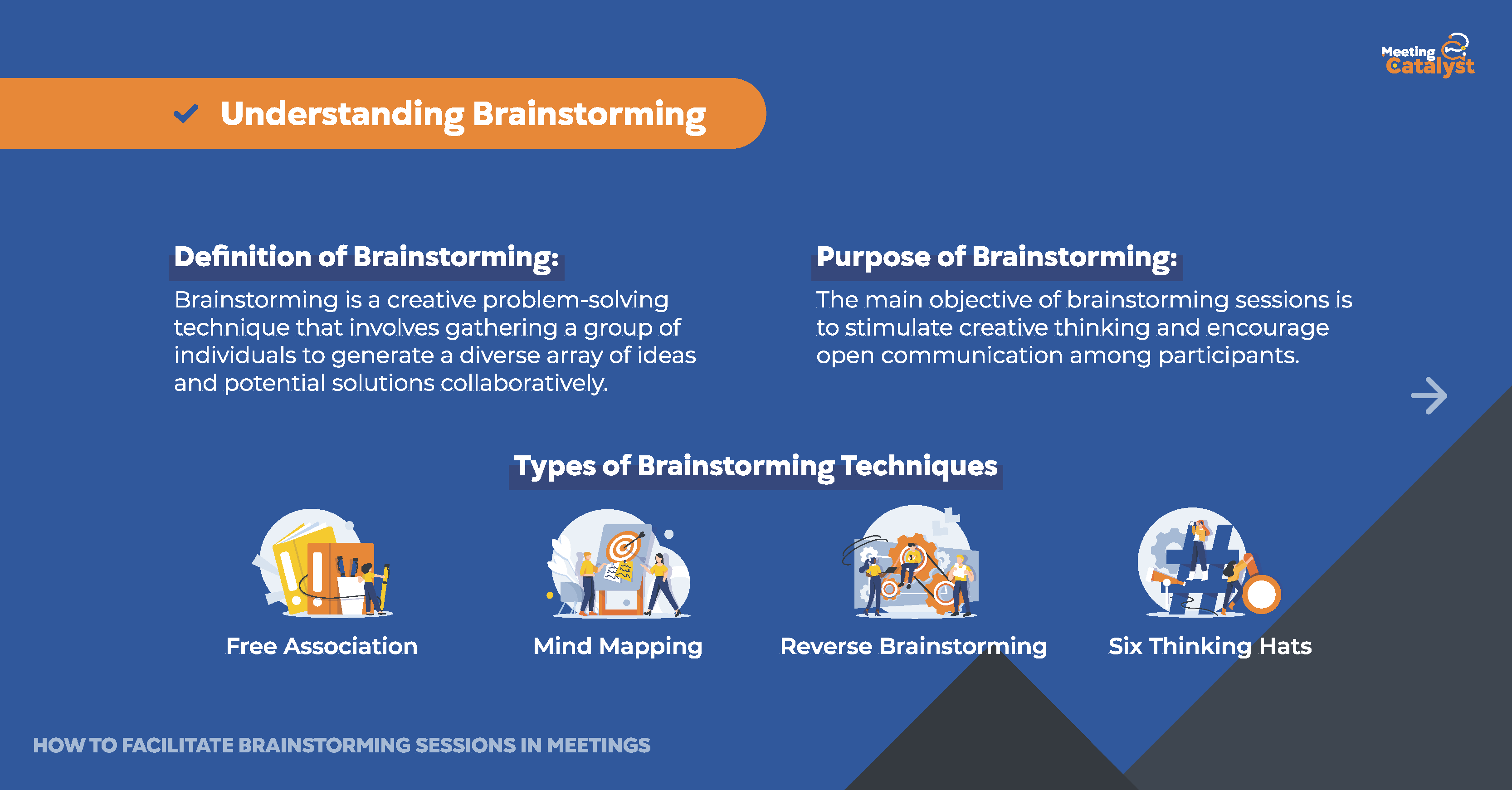
Before diving into the techniques and best practices for facilitating brainstorming sessions, it's important to understand the fundamentals of brainstorming itself. In this section, we'll cover the definition and purpose of brainstorming, as well as the types of brainstorming techniques and their advantages and disadvantages.
Definition of Brainstorming: Brainstorming is a creative problem-solving technique that involves gathering a group of individuals to generate a diverse array of ideas and potential solutions collaboratively. The process encourages free-flowing, spontaneous contributions from all participants, allowing for the exploration of innovative and unconventional ideas.
Purpose of Brainstorming: The main objective of brainstorming sessions is to stimulate creative thinking and encourage open communication among participants. This process enables teams to tackle problems from multiple perspectives, identify potential opportunities, and come up with innovative solutions to challenges.
Types of Brainstorming Techniques: There are various brainstorming techniques that can be employed in meetings, each with its own unique approach to idea generation. Some of the most common techniques include:
- Free Association: Participants share ideas as they come to mind, without any predetermined structure or order.
- Mind Mapping: A visual technique that involves creating a diagram to represent ideas, tasks, or concepts, illustrating their relationships and connections.
- Reverse Brainstorming: Instead of generating solutions, participants focus on identifying potential problems or obstacles, which can then be addressed and resolved.
- Six Thinking Hats: A technique developed by Edward de Bono, wherein participants adopt different "thinking hats" representing various perspectives, such as creativity, emotions, and logic, to explore a problem or situation.
Advantages and Disadvantages of Brainstorming:
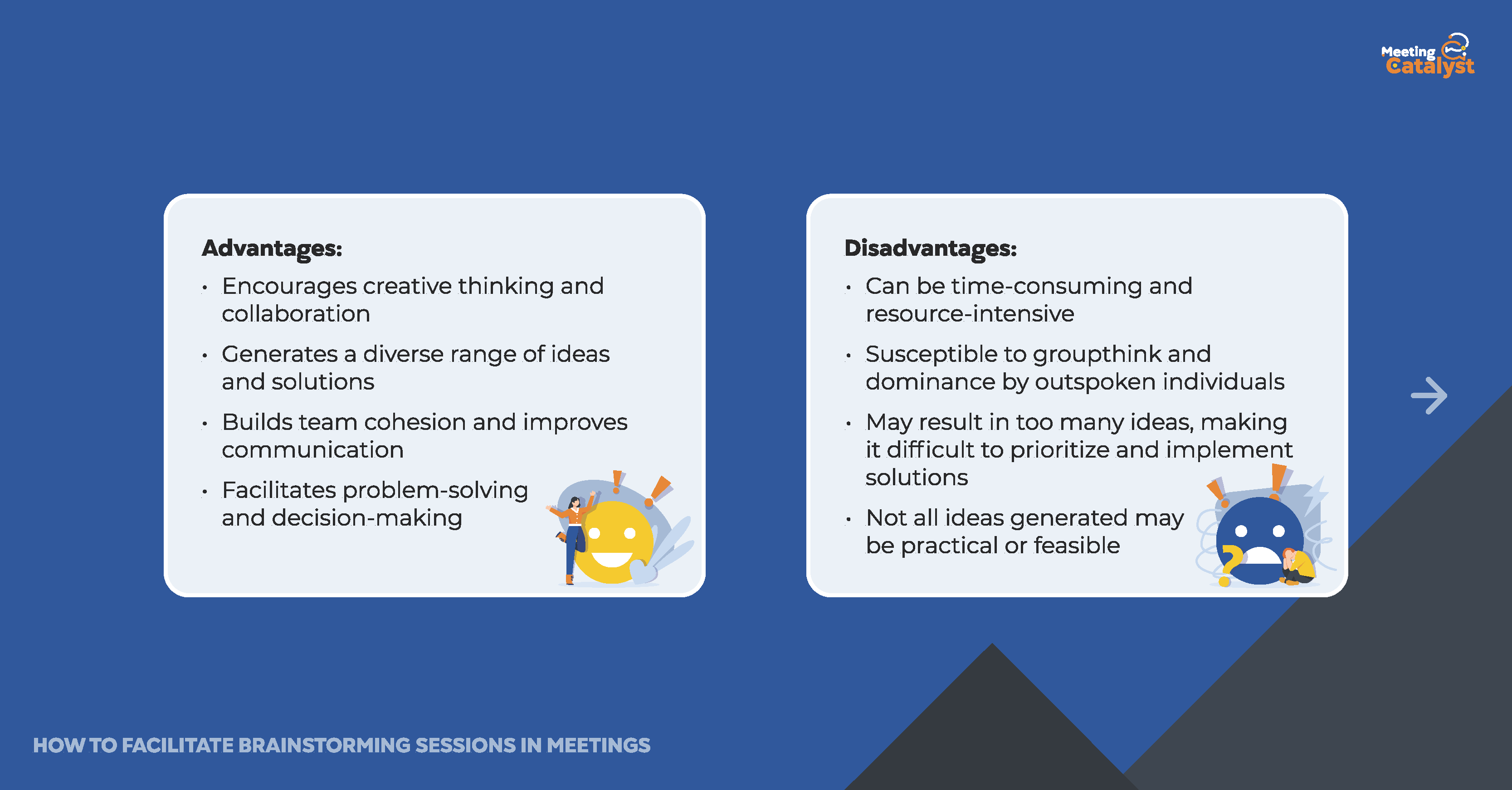
- Advantages:
- Encourages creative thinking and collaboration
- Generates a diverse range of ideas and solutions
- Builds team cohesion and improves communication
- Facilitates problem-solving and decision-making
- Disadvantages:
- Can be time-consuming and resource-intensive
- Susceptible to groupthink and dominance by outspoken individuals
- May result in too many ideas, making it difficult to prioritize and implement solutions
- Not all ideas generated may be practical or feasible
Understanding the basics of brainstorming is crucial for effectively facilitating brainstorming sessions in your meetings. By being aware of the various techniques, as well as the advantages and disadvantages, you can tailor your approach to better meet the needs and goals of your team.
Preparing for a Brainstorming Session
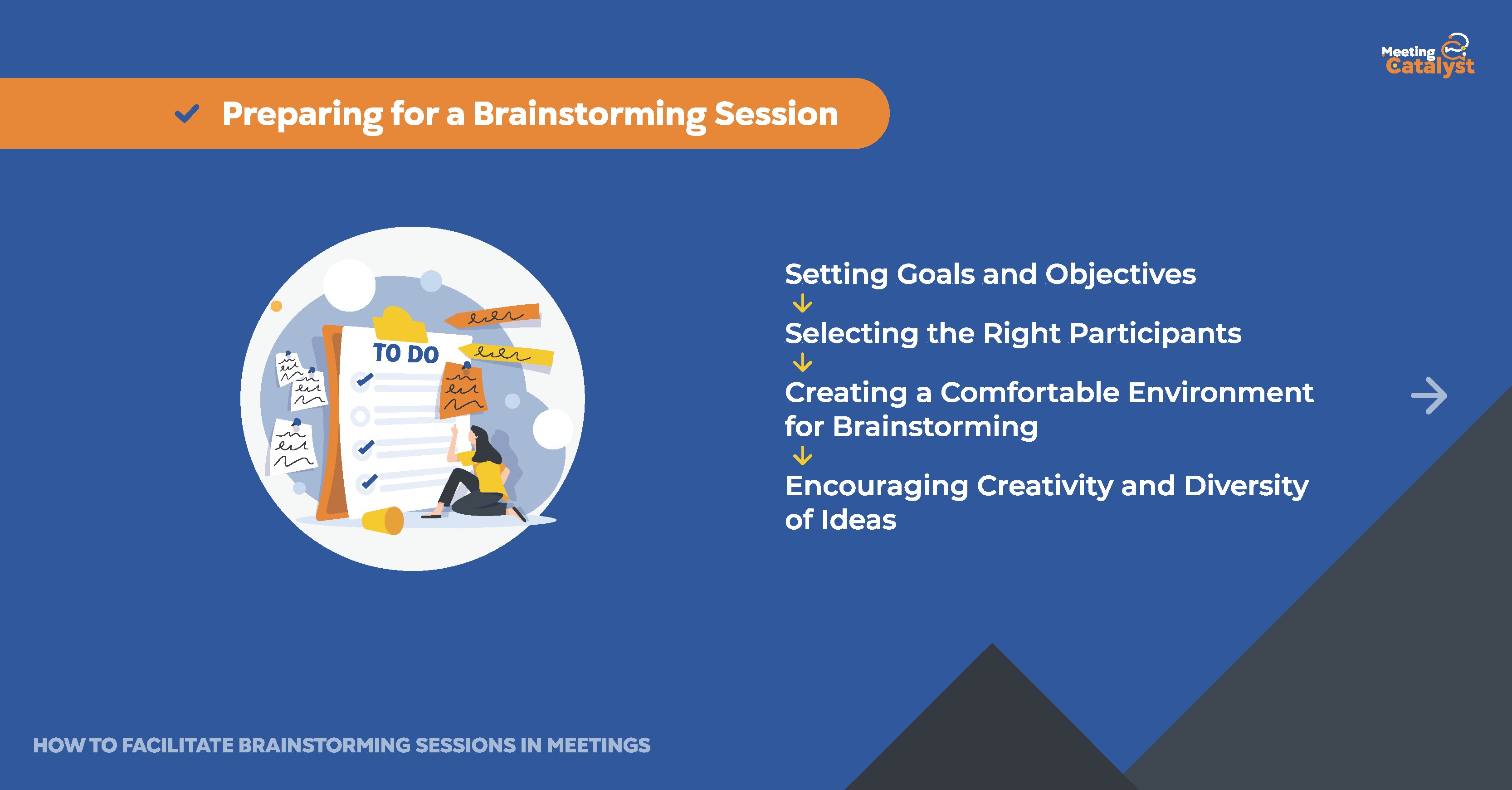
Proper preparation is key to ensuring the success of your brainstorming session. By setting clear goals, selecting the right participants, creating a comfortable environment, and encouraging creativity, you can maximize the effectiveness of your session and generate valuable ideas. In this section, we'll discuss the necessary steps to take before launching a brainstorming session.
Setting Goals and Objectives: Before the brainstorming session, it's crucial to establish the purpose and desired outcomes. Clearly articulate the problem or challenge that needs to be addressed, and set specific objectives for the session, such as generating a certain number of ideas or identifying potential solutions.
Selecting the Right Participants: The participants in your brainstorming session should be carefully chosen to ensure a diverse mix of perspectives and expertise. Consider including people with different roles, backgrounds, and skill sets, as this can foster a richer, more varied pool of ideas. Additionally, aim for a manageable group size—typically, between six and twelve participants is ideal to maintain engagement and productivity.
Creating a Comfortable Environment for Brainstorming: The physical and emotional atmosphere of the brainstorming session can greatly impact the quality of ideas generated. Choose a comfortable, well-lit space with minimal distractions. Provide materials and tools, such as whiteboards, markers, and sticky notes, to facilitate idea-sharing. Encourage an open, non-judgmental atmosphere where participants feel safe to share their thoughts and ideas without fear of criticism.
Encouraging Creativity and Diversity of Ideas: To stimulate creativity and ensure a wide range of ideas, consider incorporating icebreakers, warm-up exercises, or creative prompts at the beginning of the session. These activities can help break down barriers, energize participants, and set the stage for a productive brainstorming session. Additionally, remind participants to embrace unconventional thinking and be open to ideas that may initially seem outlandish or impractical.
By carefully preparing for your brainstorming session, you can set the stage for a productive, engaging, and creative experience that yields valuable insights and innovative solutions. In the following sections, we'll explore specific brainstorming techniques and tools, as well as best practices for facilitating the session itself.
Brainstorming Techniques and Tools
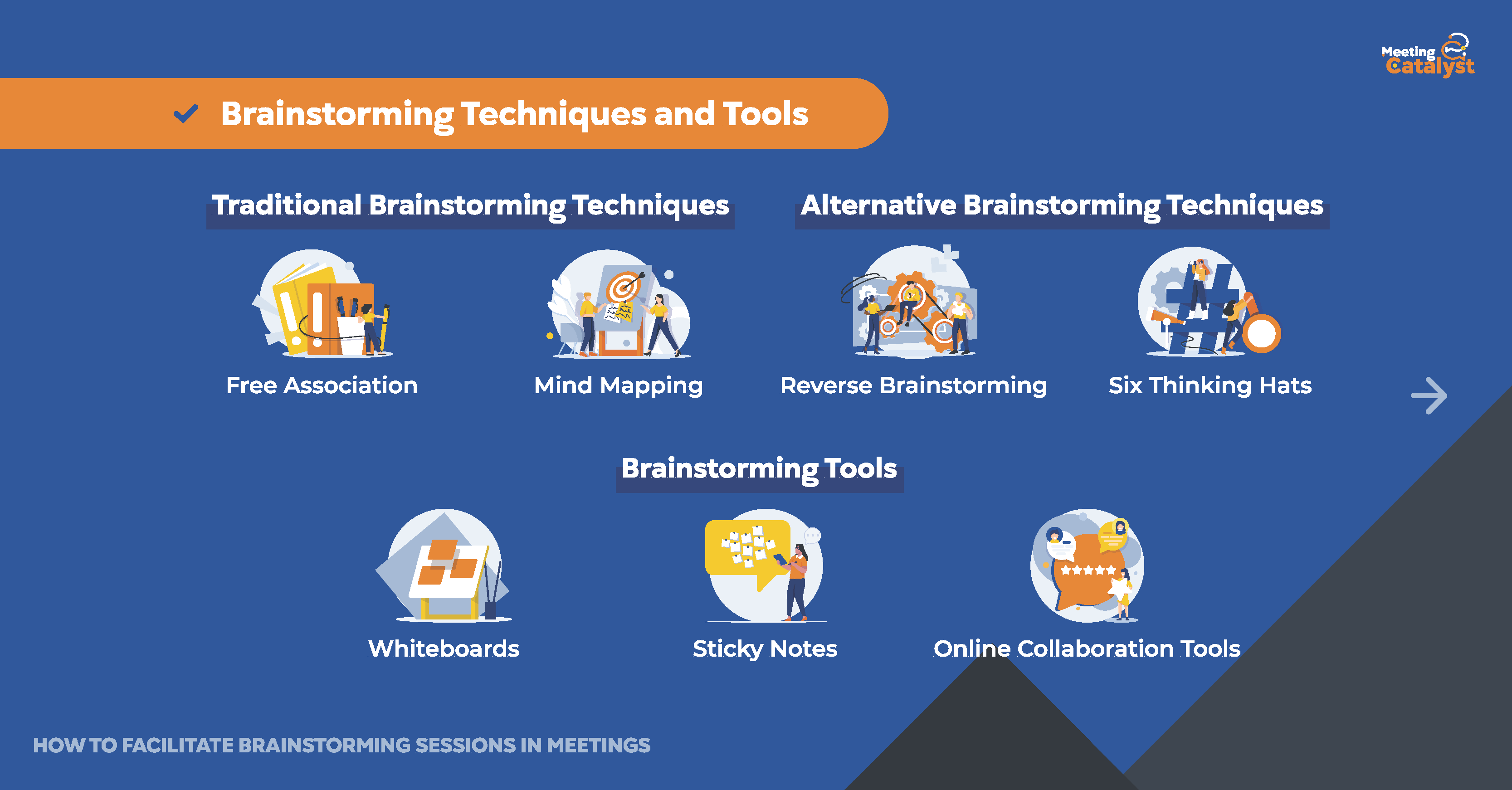
There are various brainstorming techniques and tools available to help facilitate effective idea generation. By selecting the right approach and utilizing the appropriate tools, you can encourage a productive and engaging brainstorming session. In this section, we will explore traditional and alternative brainstorming techniques, as well as useful tools to support your session.
Traditional Brainstorming Techniques: These techniques are commonly used and widely recognized for their effectiveness in generating ideas.
- Free Association: This approach encourages participants to share any ideas that come to mind, no matter how unrelated they may seem. This spontaneous flow of ideas can help inspire new connections and creative solutions.
- Mind Mapping: This visual technique involves creating a diagram with a central theme or problem, and then branching out with related ideas and subtopics. Mind mapping encourages participants to think holistically and explore the connections between ideas.
Alternative Brainstorming Techniques: These techniques offer a different approach to idea generation and may be useful in certain situations or with specific groups.
- Reverse Brainstorming: This method involves identifying potential problems or challenges related to the central issue, rather than focusing on solutions. By considering potential pitfalls, participants can gain new insights and develop innovative solutions.
- Six Thinking Hats: Developed by Edward de Bono, this technique assigns different "hats" or roles to participants, encouraging them to think from various perspectives. This structured approach can help ensure a well-rounded discussion and diverse range of ideas.
Brainstorming Tools: Utilizing various tools can enhance the brainstorming process and make it easier for participants to share and organize ideas.
- Whiteboards: Whiteboards provide a large, visible surface for participants to write down ideas and see others' contributions. This can help facilitate discussion and collaboration.
- Sticky Notes: Sticky notes are a simple yet effective tool for capturing and organizing ideas. Participants can write individual ideas on notes and then group or rearrange them as needed.
- Online Collaboration Tools: For remote or hybrid teams, online collaboration tools like Miro, Mural, or Trello can provide a virtual space for brainstorming sessions. These platforms allow participants to share and organize ideas in real-time, just as they would in a physical meeting.
By choosing the right brainstorming techniques and tools for your session, you can maximize engagement and creativity among participants, ultimately leading to more productive and successful idea generation. In the next section, we will discuss how to facilitate the brainstorming session itself, including establishing ground rules, managing group dynamics, and ensuring effective time management.
Facilitating the Brainstorming Session
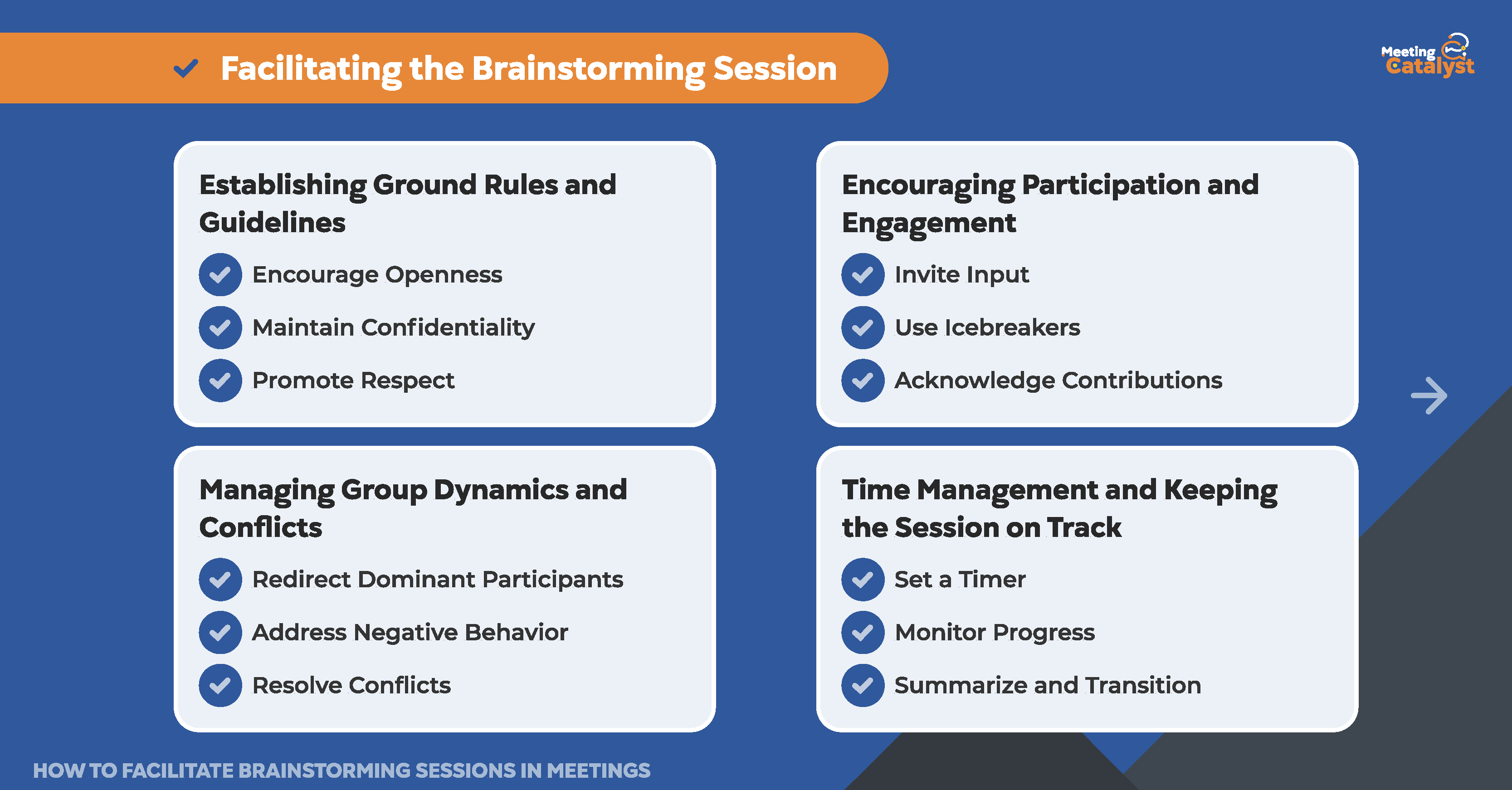
As a facilitator, your role is crucial in ensuring a productive and engaging brainstorming session. In this section, we will explore how to establish ground rules, encourage participation, manage group dynamics, and maintain effective time management during the session.
Establishing Ground Rules and Guidelines: Clearly communicate the rules and expectations at the beginning of the session to create a safe and supportive environment for idea generation.
- Encourage Openness: Remind participants that all ideas are welcome and there are no "bad" ideas during brainstorming.
- Maintain Confidentiality: Assure participants that their contributions will be kept confidential, fostering trust and openness.
- Promote Respect: Encourage participants to listen to others, avoid interrupting, and be supportive of their colleagues' ideas.
Encouraging Participation and Engagement: Ensure all participants have the opportunity to contribute and feel valued during the session.
- Invite Input: Actively invite input from quieter participants and create opportunities for everyone to contribute.
- Use Icebreakers: Start the session with a short icebreaker activity to help participants feel comfortable and energized.
- Acknowledge Contributions: Show appreciation for participants' ideas and contributions, reinforcing a positive and supportive atmosphere.
Managing Group Dynamics and Conflicts: Be prepared to address any conflicts or challenges that arise during the session.
- Redirect Dominant Participants: If a participant is dominating the conversation, gently redirect them and provide opportunities for others to contribute.
- Address Negative Behavior: If a participant is being overly critical or negative, remind them of the ground rules and encourage a more positive approach.
- Resolve Conflicts: If conflicts arise, address them calmly and professionally, ensuring the focus remains on the brainstorming session.
Time Management and Keeping the Session on Track: Maintain control over the session's schedule and ensure it stays focused and productive.
- Set a Timer: Establish a time limit for each phase of the brainstorming session, using a visible timer to help participants stay on track.
- Monitor Progress: Periodically check in on the session's progress, adjusting the schedule or refocusing the discussion as needed.
- Summarize and Transition: Summarize the main points and ideas at the end of each phase, and smoothly transition to the next part of the session.
By effectively facilitating the brainstorming session, you can create an environment that encourages creativity, collaboration, and the generation of valuable ideas. In the following sections, we will discuss how to follow up after the session, address common challenges, and implement best practices for successful brainstorming.
Post-Brainstorming Follow-Up
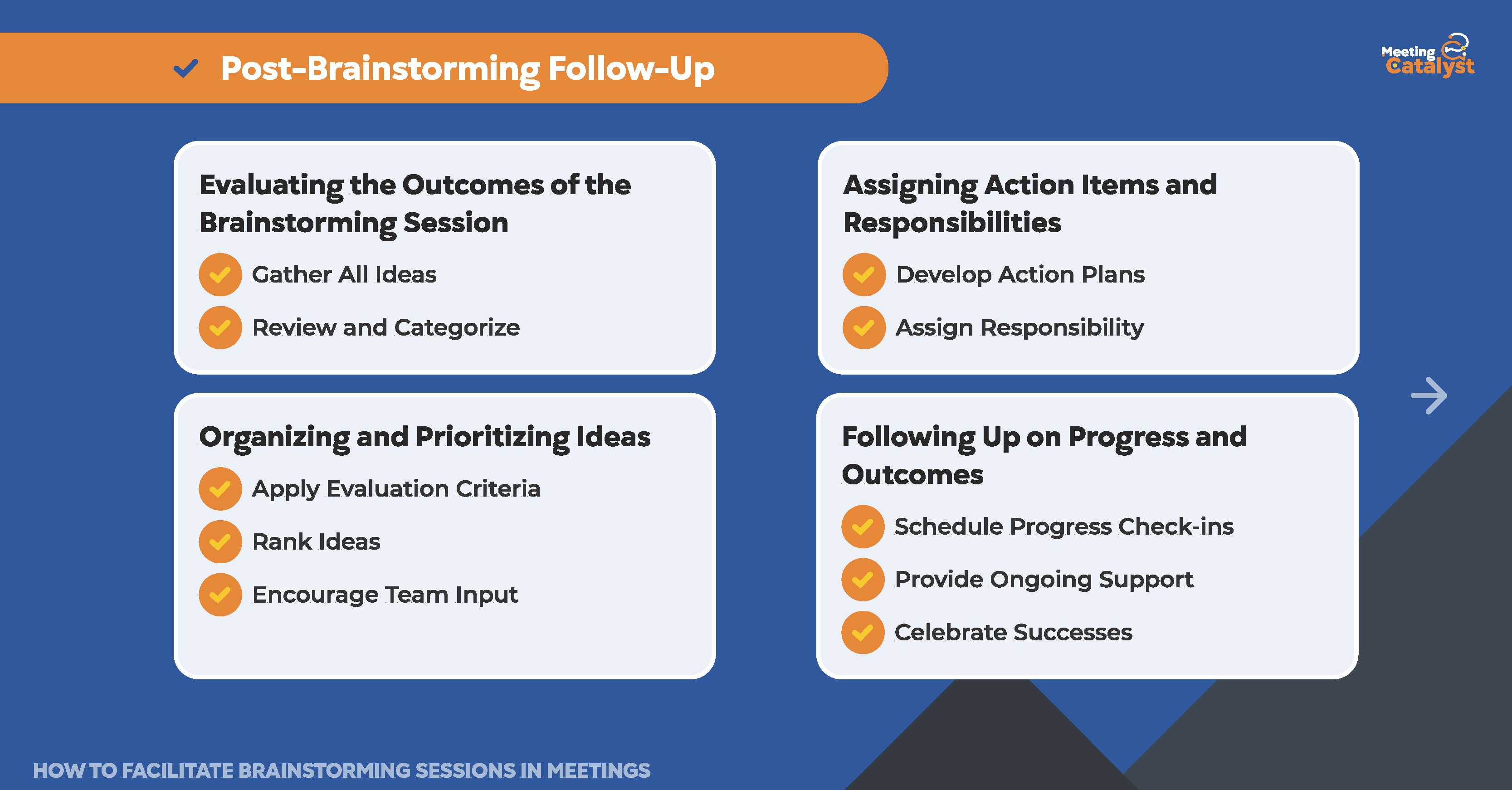
Once the brainstorming session has concluded, it's essential to capitalize on the momentum and energy generated by effectively following up on the outcomes. In this section, we'll discuss how to evaluate the results, organize and prioritize ideas, assign action items, and follow up on progress and outcomes.
Evaluating the Outcomes of the Brainstorming Session: Review the ideas generated during the session and assess their quality and relevance.
- Gather All Ideas: Ensure that all ideas have been collected and documented, whether on whiteboards, sticky notes, or digital collaboration tools.
- Review and Categorize: Examine the ideas and group them into categories or themes for further analysis and discussion.
Organizing and Prioritizing Ideas: Determine which ideas have the most potential and should be prioritized for further exploration.
- Apply Evaluation Criteria: Establish criteria for evaluating ideas, such as feasibility, alignment with company goals, or potential impact.
- Rank Ideas: Rank the ideas based on the evaluation criteria, identifying the top contenders for further development and action.
- Encourage Team Input: Involve the team in the prioritization process, providing them with a sense of ownership and commitment to the chosen ideas.
Assigning Action Items and Responsibilities: Ensure that each prioritized idea has a clear action plan and an individual or team responsible for its execution.
- Develop Action Plans: Break down each idea into actionable steps and establish timelines for their completion.
- Assign Responsibility: Allocate specific tasks and responsibilities to team members, ensuring that they have the necessary resources and support to carry them out.
Following Up on Progress and Outcomes: Maintain accountability and track the progress of the ideas that emerged from the brainstorming session.
- Schedule Progress Check-ins: Establish regular check-ins to discuss the status of the action plans and address any challenges or roadblocks.
- Provide Ongoing Support: Offer ongoing guidance and resources to team members as they work on their assigned tasks and responsibilities.
- Celebrate Successes: Recognize and celebrate the successful implementation of ideas, reinforcing a culture of creativity and innovation.
By effectively following up on the outcomes of your brainstorming session, you can ensure that the valuable ideas generated are put into action and contribute to the success of your organization. In the next sections, we will explore common challenges and solutions in brainstorming sessions and discuss best practices for facilitating successful brainstorming sessions.
Common Challenges and Solutions
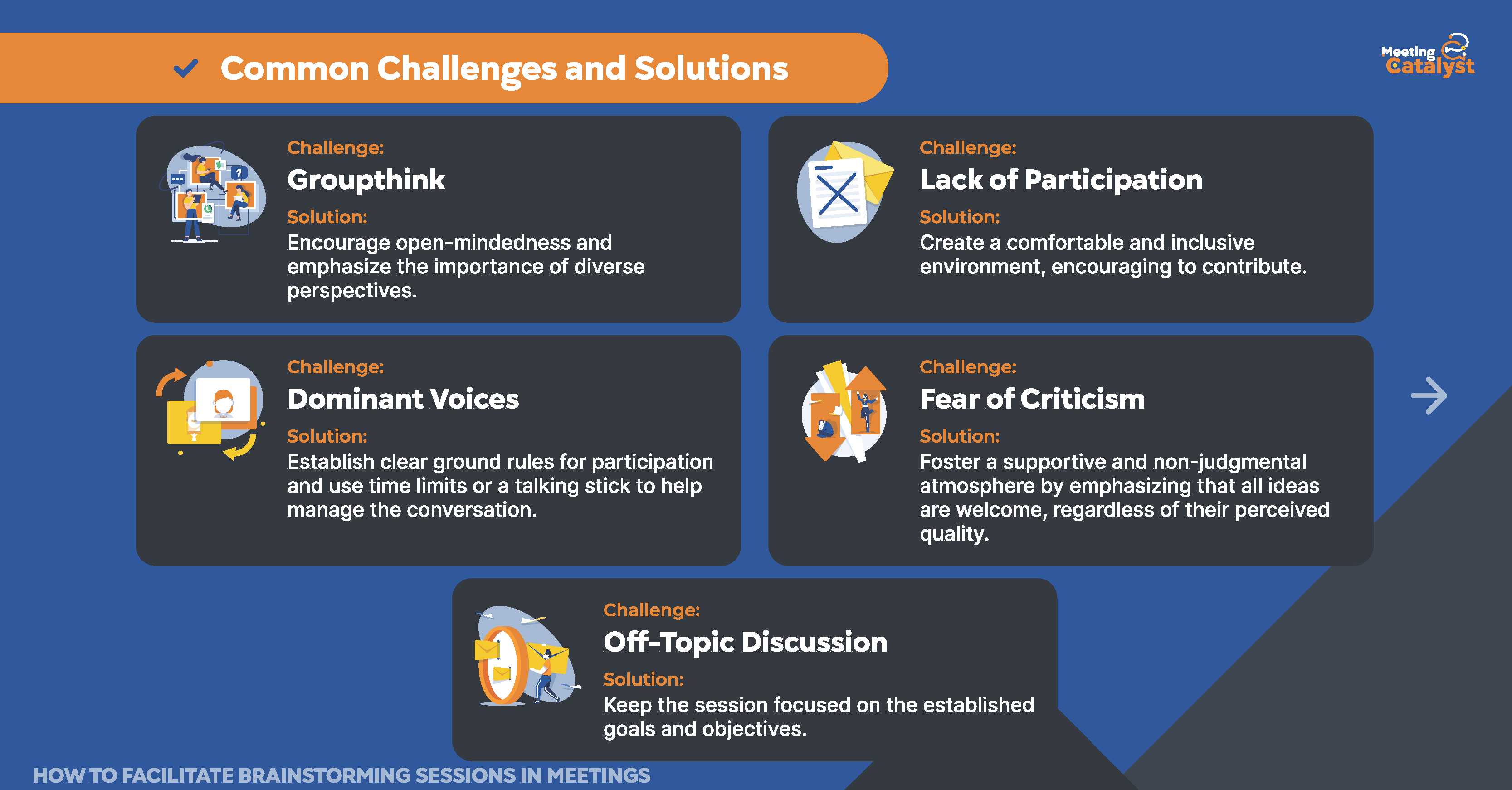
Brainstorming sessions can sometimes face a variety of challenges that can hinder their effectiveness. In this section, we'll discuss some common obstacles and provide solutions to help overcome these issues, ensuring a successful and productive brainstorming session.
Groupthink: Groupthink occurs when participants feel pressure to conform to the opinions of the majority, leading to a lack of diverse ideas and critical thinking.
- Solution: Encourage open-mindedness and emphasize the importance of diverse perspectives. Provide opportunities for anonymous idea submission and use techniques like the six thinking hats to promote different ways of thinking.
Lack of Participation: Some participants may feel shy or intimidated, preventing them from sharing their ideas during the session.
- Solution: Create a comfortable and inclusive environment, encouraging everyone to contribute. Implement techniques like round-robin brainstorming to ensure everyone gets a chance to speak.
Dominant Voices: Overbearing individuals can take over the conversation, preventing others from contributing their ideas.
- Solution: Establish clear ground rules for participation and use time limits or a talking stick to help manage the conversation. As the facilitator, intervene when necessary to ensure equal opportunities for all participants.
Off-Topic Discussions: Participants may veer off course, discussing irrelevant issues and wasting valuable time.
- Solution: Keep the session focused on the established goals and objectives. Gently steer the conversation back on track when participants veer off-topic, and consider creating a "parking lot" for unrelated ideas to be addressed later.
Fear of Criticism: Participants may hesitate to share their ideas due to fear of judgment or ridicule from their peers.
- Solution: Foster a supportive and non-judgmental atmosphere by emphasizing that all ideas are welcome, regardless of their perceived quality. Remind participants of the "no criticism" rule during the brainstorming session.
By recognizing and addressing these common challenges, you can create a more effective brainstorming session that encourages open communication, diverse perspectives, and creative problem-solving. In the next section, we'll explore the best practices for facilitating brainstorming sessions, helping you to lead successful and productive sessions in your meetings.
Best Practices for Facilitating Brainstorming Sessions
In this section, we'll summarize the key takeaways and best practices for effectively facilitating brainstorming sessions. By implementing these strategies, you can create an environment that fosters creativity, collaboration, and problem-solving, ultimately leading to more successful and productive meetings.
Set Clear Goals and Objectives: Clearly define the purpose of the brainstorming session and establish specific goals to keep the session focused and on track.
Select the Right Participants: Invite a diverse group of individuals with varied perspectives, skills, and expertise to encourage a wide range of ideas.
Create a Comfortable Environment: Ensure that the meeting space is conducive to creativity, providing comfortable seating, adequate lighting, and any necessary materials or tools.
Encourage Creativity and Diverse Ideas: Foster an atmosphere of open-mindedness and inclusivity, allowing for the free exchange of ideas without judgment or criticism.
Utilize a Variety of Brainstorming Techniques: Employ a mix of traditional and alternative brainstorming methods, such as mind mapping, reverse brainstorming, or six thinking hats, to stimulate different modes of thinking.
Establish Ground Rules: Set guidelines for participation, emphasizing the importance of respecting others, avoiding criticism, and staying on topic.
Manage Group Dynamics: As the facilitator, actively guide the conversation, ensuring equal opportunities for all participants and intervening when necessary to maintain a balanced and inclusive discussion.
Keep Time: Set time limits for idea generation and discussion to maintain momentum and keep the session focused on the established goals.
Follow Up and Evaluate: Organize and prioritize the ideas generated during the session, assigning action items and responsibilities, and periodically checking in on progress and outcomes.
By incorporating these best practices into your brainstorming sessions, you can effectively lead your team through productive and engaging meetings that yield valuable insights, creative solutions, and improved collaboration. In the next section, we'll wrap up our discussion on facilitating brainstorming sessions with a conclusion that reinforces the importance of these strategies and provides a call-to-action for readers to implement them in their own meetings.
Conclusion
As we've explored throughout this article, effectively facilitating brainstorming sessions is crucial for business and team leaders who want to maximize the potential of their meetings. By creating an environment that fosters creativity, collaboration, and open-mindedness, you can empower your team to generate innovative ideas, solve complex problems, and ultimately drive your organization forward.
To recap, some of the key strategies for successful brainstorming sessions include:
- Understanding the purpose and benefits of brainstorming
- Preparing thoroughly by setting goals, selecting participants, and creating a comfortable environment
- Utilizing a variety of brainstorming techniques and tools
- Actively facilitating the session, managing group dynamics, and keeping time
- Following up on the outcomes and evaluating the success of the session
- Overcoming common challenges and implementing best practices
By embracing these strategies and putting them into practice, you can transform your brainstorming sessions into powerful catalysts for innovation and growth within your organization.